The Central Bank of Oman (CBO) has developed a Macro Stress Testing framework to assess the resilience of the Omani banking system to adverse macroeconomic events.
As per the CBO, a macro-financial model is used to predict the impact of changes in macro variables on banks’ credit quality and consequently on capitalisation.
The default rate and the non-performing loans (NPL) ratio for 2022 were projected based on shocks to the oil prices (which impact real GDP growth), inflation, interest rate, and stock returns. The table below illustrates performances under these parameters.
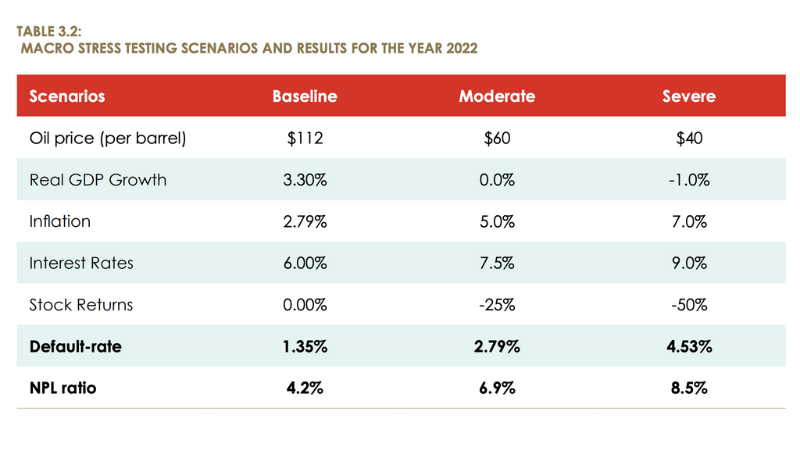
Elasticities of these variables were estimated using the macro-financial model in a multivariate regression framework.
Under the moderate macro shocks, the expected mean default rate of banks’ credit portfolios over 2022 would be 2.79 per cent. Consequently, the NPL ratio will increase from 4.2 per cent to 6.9 per cent, banking Capital To Risk-Weighted Assets Ratio (CRAR) will drop from 19.4 per cent as of December 31, 2021, to 18.2 per cent.
The CRAR of individual banks were recalculated after considering the additional provisioning expenses (65 per cent of new NPLs) and the profit buffer. A shock of 15 per cent reduction in net interest income is assumed for the bank’s profits for the year 2022.
Under a moderate scenario, all banks, except one, would comply with the minimum required CRAR of 12.25 (refer to the graph below).
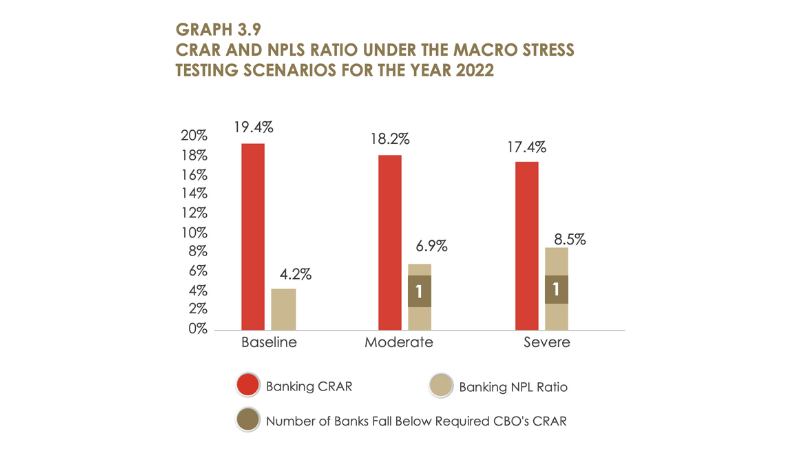
In the event of severe macro shocks, the gross NPL ratios of the banking system would increase from 4.2 per cent to 8.5 per cent. Consequently, the banking CRAR would be reduced to 17.4 per cent.
All domestic banks, except one, would comply with the minimum domestic required CRAR.
Using macroeconomic and banking sector data, namely, real GDP growth, quarterly stock market prices, quarterly consumer inflation and quarterly lending rates for Q2 1999 –Q4 2021, a macro-credit risk model is estimated for projecting the default rate for Oman by a simple Ordinary Least Squares (OLS) regression model.
The model uses the 12-month default rate, which expresses new NPLs over a horizon of one year as a percentage of the initial stock of performing loans, as the dependent variable, and main macro-financial variables (GDP growth, lending rate, inflation rate and stock market index) as explanatory variables.
The forecasted default rate – either itself or its long-run average – can be understood as a probability of default (PD). Among the dependent variables, the aggregate default rate (DFRATE), calculated as new NPLs over a period of four consecutive quarters as a percentage of the initial stock of performing loans, is a flow indicator that shows what proportion of performing loans defaulted over a period of one year, and in principle it is the same indicator used by banks to calculate probability of default (PD).
Secondly, the use of a flow indicator (default rate capturing new NPLs) is superior to the use of stock indicators (such as the NPL ratio), as the flow indicator is much more linked to provisioning (credit losses), which impacts the overall profitability of banks and ultimately their solvency (Hardy and Schmieder, 2013).
The numerator of DFRATE is the 4-quarter sum of new NPLs, while the denominator is the stock of performing loans (calculated as a stock of all loans minus stock of NPLs) at the end of the previous quarter.
For example, the default rate (DFRATE) for Q1-2010 is thus the ratio between the sum of quarterly new NPLs over the period from Q1-2010 to Q4-2010 and the stock of performing loans at the end of Q4 2009.
Among the explanatory variables, real GDP growth (GDPGROWTH), lending rates (NOMINALRATE), inflation rate (INFLATION), and stock market returns (STOCKMARKET) were used.
Real GDP growth is one of the most used explanatory variables for credit risk given its usually high (negative) correlation with credit risk indicators due to its direct effect on borrowers’ income and thus their capacity to service the debt.
Some papers only consider this variable for satellite models, and this variable is also often used for various rules of thumb elasticities (Hardy and Schmieder 2013; Schmieder et al. 2011).
Second, for consumer price inflation, literature on stress testing models usually works with ex-post rather than ex-ante real rates (i.e. using inflation of the given quarter as a proxy for inflation expectations), as these seem to be more correlated with actual defaults (Buncic and Melecky, 2012).
It is the inflation outcome after a loan has been granted, that influences the borrower’s capacity to service the loan in real terms rather inflation expectations at the moment of taking up the loan.
Third, as of the stock market returns, given that the existing stress testing framework in Oman assumes a stock price shock, the inclusion of this variable in the model linking the macro-financial environment with banks’ credit risk would provide an additional channel through which the stock price shock impacts banks (in addition to market risk).
The model includes a lagged dependent variable to prevent auto-correlated residuals, and uses robust standard errors to take care of possible residual autocorrelation and heteroscedasticity.
The signs of the estimated coefficients are in line with expectations. The coefficient for inflation is not statistically significant (p-value of 0.69), but it was decided to keep it in the estimated model. The sign of the inflation coefficient is not clear ex-ante. While higher inflation lowers the real debt burden, suggesting a negative sign, higher inflation – especially if not reflected in wage inflation – may also decrease the real disposable income of households and make repayment debt more difficult, suggesting a positive sign. The Omani experience confirms the latter argument amid the food price inflation in 2008-2009.
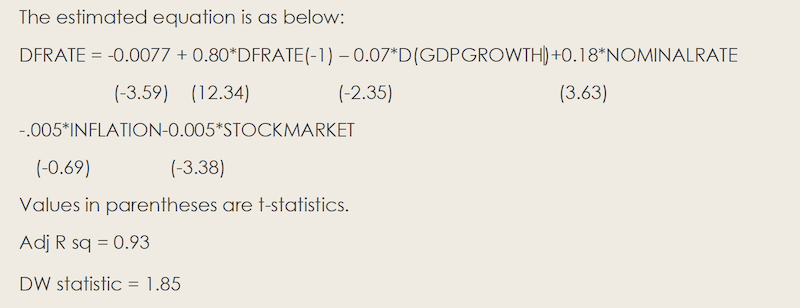
Using the above macro-financial model’s elasticity estimates for all these variables, it can be seen that a decrease in real GDP growth by 1 percentage point increases the default rate by 0.07 percentage points. An increase in interest rates by 1 percentage point increases the default rate by 0.18 percentage points, whereas a decrease in stock market prices by 1 percentage point increases the default rate by 0.005 percentage points. Using these coefficients, the default rate for December 2022 is estimated at of 1.35, 2.79 and 4.53 per cent in the baseline, moderate and severe scenarios, respectively.
Liquidity Stress Test
For assessing the liquidity buffers of domestic banks, CBO examines the ability of banks to withstand excessive cash outflows over a short time horizon. The liquidity stress test aims to determine the number of days that banks can survive an elevated and unforeseen rate of withdrawals relying solely on their liquid assets, assuming that the capital and interbank markets are not accessible for funding.
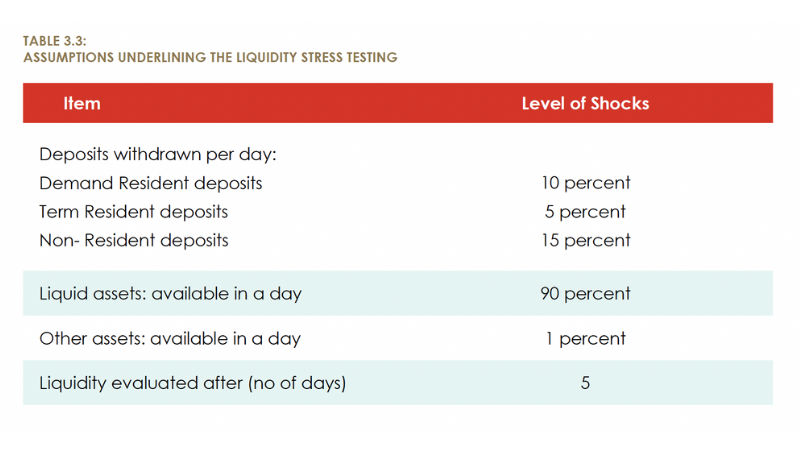
As of 31st December 2022, under the assumed liquidity stress scenario, all banks except for two could withstand the assumed sudden deposit withdrawals for at least five working days.
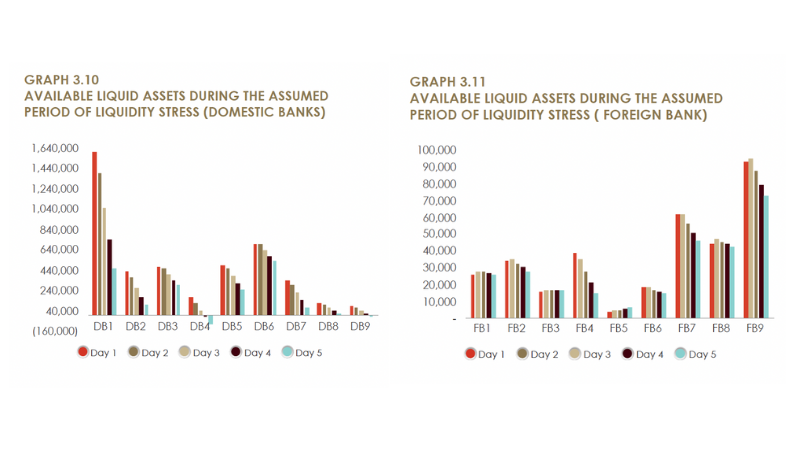
During the past five years, domestic banks have increased their holdings of government securities, which may be used to secure additional liquidity when needed.






